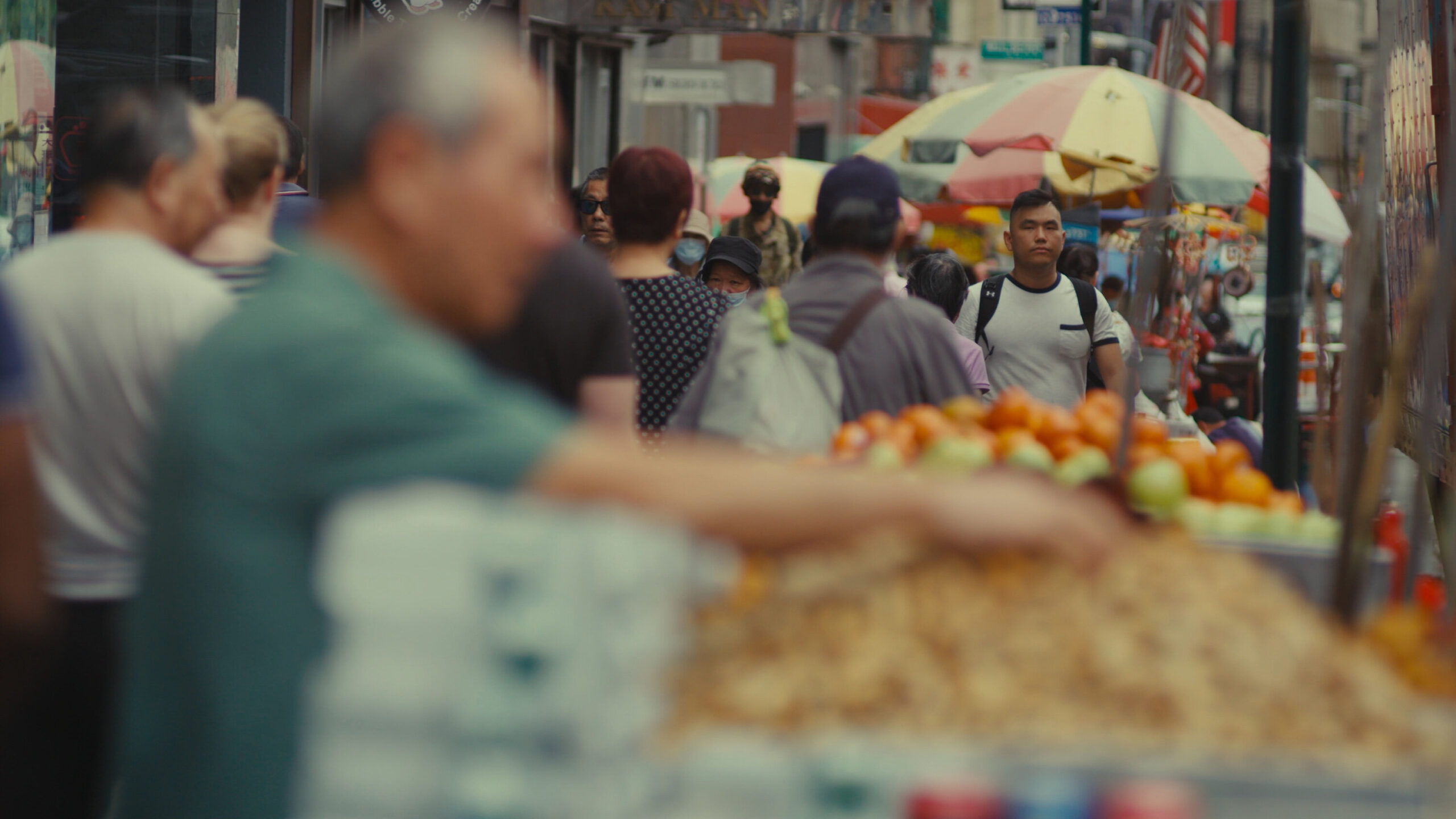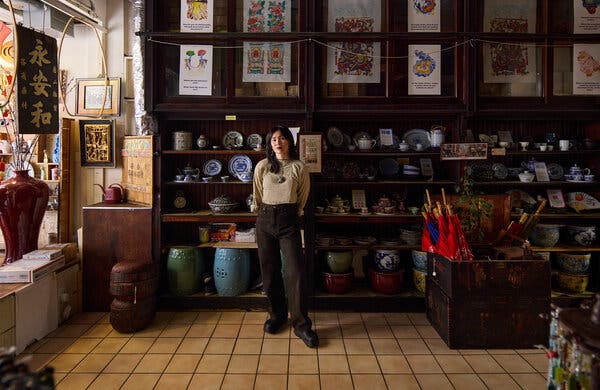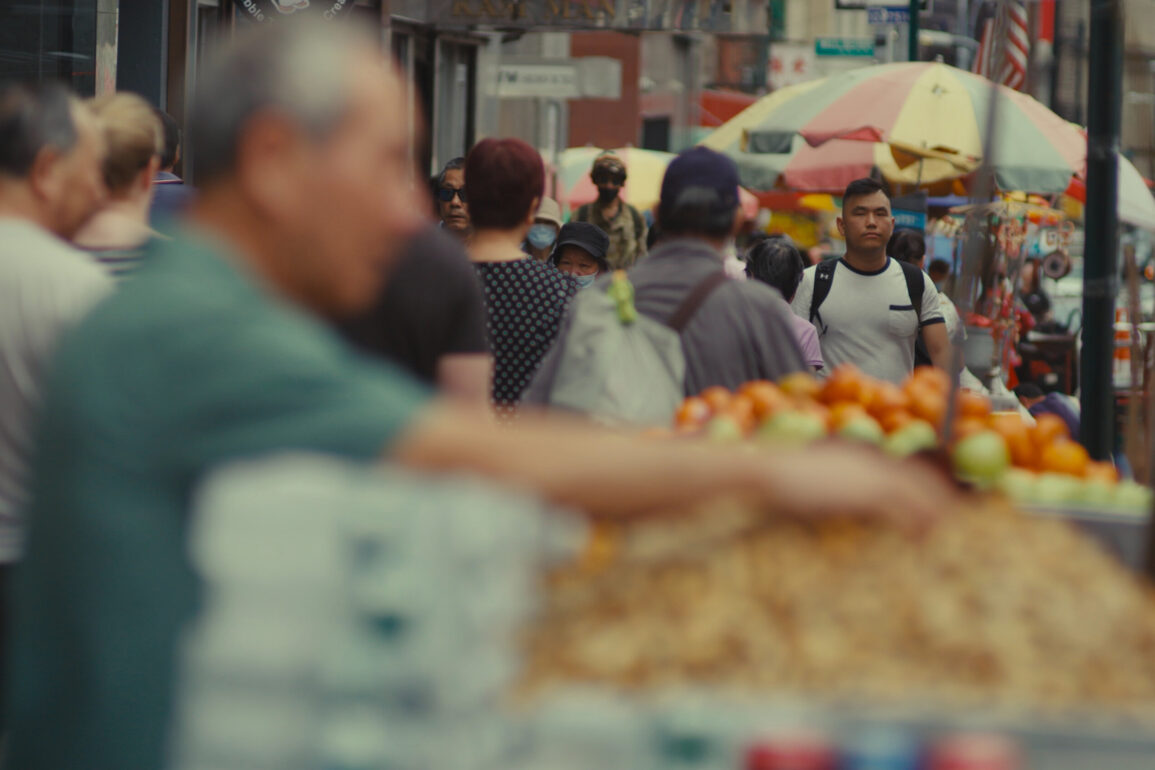SOME NIGHTS, IN her bedroom in a former tenement in downtown Manhattan, the fashion designer Sandy Liang can hear the strains of “Happy Birthday” filtering up through the floorboards from Congee Village, the restaurant that her father opened in 1996, when she was 5. So many times she’s listened to the waiters sing those bars, on her birthday and her brother’s, year after year, every milestone celebrated in that fantastical dining room tricked out with fake trees. Back then, the address was just outside of Chinatown, which emerged in the 1870s within the predominantly Irish and later Italian Five Points slum, at the bracket of Bayard, Mott and Pell Streets. The New York Times first mentions the neighborhood by name in 1880, coolly noting that a few property owners in the area refused to take Chinese tenants, while others demanded rents “considerably above those paid by Christians.” These days, depending on whom you ask, the neighborhood sprawls from Delancey Street down to Chambers Street, west to Broadway and east as far as the river.

In Liang’s childhood memory of the restaurant’s early days on Allen Street just below Delancey, there weren’t a lot of Chinese in that part of the Lower East Side yet. Her family lived in Bayside, Queens, but most weekends her mother trekked across the bridge into Chinatown for groceries, and Liang slept over at her grandparents’ apartment on Rivington Street. Like many Chinese-born women who came to the United States after immigration reform in the 1960s, Liang’s paw paw, or maternal grandmother, worked at one of the neighborhood’s garment factories, which by the early ’80s numbered around 500 and employed more than 20,000 women, some making only $9 or $10 a day despite the federally mandated minimum wage of $3.35 an hour. On June 24, 1982, nearly a decade before Liang was born, almost all of those women walked off the job and took to the streets, wearing paper caps signaling their allegiance to International Ladies’ Garment Workers Union Local 23-25, to protest employers who were threatening to cut wages and pull benefits.
Listen to This Article
Now Liang, 32, is the one who makes clothes. In 2020, she opened a boutique a few blocks south of Congee Village. Nothing is crowded here, nothing loud. Winky separates — a gingham top with dangling garters, a demi-bra in power-suit gray — hang from a sinuous metal rack across from shelves of giant flower scrunchies edged in eyelet, and satin Mary Janes whose blunted toes evoke ballet shoes. The price tags wouldn’t be out of place in SoHo or up on Madison Avenue. But there’s a blithe mix-and-match sensibility to Liang’s line that collapses the distance between It girl and Chinatown grandma — sometimes literally: A shearling coat modeled by her paw paw in 2018 wound up a few years later on a magazine editor in the rebooted TV series “Gossip Girl.” For Liang, who once presented her designs at Congee Village amid plates of fried rice and chow fun, there is no contradiction. There is simply biography.
In some ways, this is the story of Manhattan’s Chinatown, too: born in another era and yet urgently of this one, old and new at once, ever in flux and yet somehow timeless, if only in the mind. Where so much of New York has submitted to the demands of capital and so many blocks have been transformed into mere real estate, this pocket of prized downtown squeezed between SoHo and TriBeCa, two of the most expensive neighborhoods in the city, has to date mostly resisted wholesale demolition and development (owing in part to the concentration of property in the hands of civic associations formed to govern the neighborhood in the late 1800s and organized by family or village ties). It has even expanded into new territory, subsuming all but three blocks of Little Italy, as well as the historically Jewish section of the Lower East Side. (The original Chinatown, to the west, was settled by those with origins in Guangdong Province, who speak Cantonese; more recent immigrants, from Fujian Province and speaking Mandarin and Fujianese, have staked a claim to the east.) As other quarters in Manhattan have started to change in character (Washington Heights, whose Dominican population has declined; Harlem, no longer majority Black) — with both the departure of the young people raised there and the arrival of outsiders in search of cheaper rents or the aura of cool that comes with living on an imagined fringe — Chinatown has remained recognizably Chinatown.
But whose Chinatown? For tourists looking for an easily accessible exotic within an American city, there is the Chinatown of myth and surfaces, of paper lanterns and dragons, stone lions and ceramic lucky cats waving their paws, dumplings and noodles. That these items have genuine cultural value does not rescue them from the reductiveness of an outsider’s gaze. Indeed, as long as there have been Chinatowns, enterprising vendors within these communities have consciously played to non-Chinese tastes, exaggerating and diluting cultural differences as needed, as with the tempering of dishes (and the creation of almost entirely new ones) for curious but still fairly timid Western palates. The result, paradoxically, is that tourists find in Chinatown not a new world, to be learned in its particulars, but a variation on a theme, in which one noodle shop stands in for all noodle shops and one Chinatown for all Chinatowns, across the country and the world.
Even for many American-born Chinese, who may honor Chinatown less as a specific address than as a testament to immigrant adaptability and resilience and a metaphorical marker of origins regardless of whether their ancestors passed through it, the neighborhood is essentially a place to visit — to come for dim sum on weekends, like tourists. Today Manhattan’s Chinatown has been surpassed in size by Chinatowns in Flushing, Queens, and Sunset Park, Brooklyn. A 2022 city report, drawing on census statistics for tracts that approximate the neighborhood’s physical plant, puts the total population at 57,159, of which 34,295 (60 percent) are of Asian descent.

At the same time, a number of young Chinese Americans are choosing, like Liang, to anchor themselves in the neighborhood, a reversal of traditional patterns of assimilation, in which the children of immigrants tend to leave crowded urban ethnic enclaves for the expansiveness of suburbia. Some have family here: Vic Lee, 33, of the nonprofit organization Welcome to Chinatown, has a tattoo on her elbow of a rice bowl with the number 135, a homage to her grandmother’s longtime address, 135 Eldridge Street. Others are newcomers, drawn perhaps out of a desire to reconnect with the culture of their forebears or wanting the comfort of the familiar — the food they ate as children; the sound of the language their grandparents spoke; the greetings and mild scoldings from the elders they meet on the street, whom they call aunties and uncles — or for a sense, however inchoate, of belonging. The filmmaker Connor Sen Warnick, 27, moved to Chinatown a year and a half ago, to a railroad apartment with the shower in the kitchen, because, he says, “in other spaces, I was always reminded that I was Asian and overlooked or misunderstood.”
It is the simplest kind of freedom, to feel at one with your surroundings; to be able to melt into the crowd. The California-born architect Dong-Ping Wong, 43, of Food New York, opened an office in 2018 at the western end of East Broadway, a part of Chinatown where few tourists wander. “Here I can not feel foreign,” he says. “I can disappear.”
UNDER THE QING dynasty (1644-1911), Chinese imperial subjects were discouraged or outright prohibited from going overseas. But the First Opium War, which ended in 1842 with the British forcing China into trade concessions, sapped the empire’s power, and people in the southern coastal province of Guangdong — home to the only port in China that was open to Westerners — felt emboldened to seek opportunities in America. They were greeted as usurpers of jobs and, in the West, then still a lawless frontier, many were brutalized and massacred.
An ethnic enclave within a city was not so much a choice as a necessity, then, for protection, and because discrimination made it nearly impossible to rent and find work elsewhere. In the United States, immigrant neighborhoods have typically functioned as liminal spaces, way stations for nascent Americans en route to a less conspicuous life. But while Irish, German and, later, Southern and Eastern European immigrants were eventually folded into mainstream white America (the descendants of Western and Northern European colonialists), for the Chinese there was no path to assimilation; they were viewed as forever foreign, a notion that, as Wong points out, persists to this day.
In 1882, Congress passed the Chinese Exclusion Act, strictly limiting Chinese immigration for the next six decades. (It was not repealed until 1943, after China had become the United States’ ally in World War II.) Manhattan’s Chinatown grew nevertheless, albeit with a dramatically skewed gender ratio: Because the Page Act of 1875 had effectively banned Chinese women from entering the country (ostensibly to curtail human trafficking and prostitution, although likely an underlying motive was to prevent Chinese immigrants from having children on American soil), by 1900 Chinatown was home to 7,028 men but only 142 women — a ratio of nearly 50 to 1, according to research by the Hong Kong-based historian Xinyang Wang. The neighborhood didn’t approach gender parity until the 1970s, after national origin quotas for immigration were abolished.
For some, it can be difficult to distinguish Chinatown as a historic site from the living neighborhood of today. “People think of Chinatown as this place they just go to or used to go to — but people live here,” Rochelle Kwan, 30, who collects oral histories for the nonprofit organization Think!Chinatown, says. “I’m one of them.”
TO AN OUTSIDE observer, Chinatown is at once vivid and invisible. You walk the streets, past the park with Cantopop from tinny radios lilting over thunked basketballs, the twang of a qinqin (plucked lute) and the sly murmur of xiangqi (Chinese chess) masters and aunties playing cards; past cooks in peaked hats on smoke break and street vendors by the Manhattan Bridge ever proclaiming, waving at orange-clawed crabs nestled in baskets, boxes of Ritz crackers, green beans spilled on newspaper, hot pink dragon fruit and musky little globes of longan hiding sweet, translucent flesh; past funeral supply shops and ginseng specialists, racks of red roasted ducks with shatter-ready skin and glassy-eyed fish over ice, grinding vans and buses destined for Virginia Beach; past restaurants whose kitchens seethe with the constant crackling static of food dropped in hot oil and industrial woks that roar like airplanes gunning to take flight; past decaying tenements riddled with faulty wiring, so quick to start fires, and doors that lead to warrens of carved-up rooms, some of them homes shared for decades by multiple generations, some crammed with cots wall to wall, rented out in eight-hour shifts by new immigrants with nowhere else to rest; past other doors, unmarked, that might conceal makeshift mahjong parlors for illegal gambling and karaoke dens up murkily lit stairs where blonde brides-to-be belt out Journey’s “Don’t Stop Believin’” while Chinatown uncles roll dice at the bar.
Even if you try to look closer, deeper, it is difficult not to fall into the trap of travelogue. And yet the energy of the streets is arguably a large part of what makes Chinatown Chinatown: a neighborhood that is as fully alive, as fully itself, in its public spaces as in its private ones. The population density alters the relationship of inside and outside. Kwan lives in a small apartment and thus spends much of her time outdoors, “hanging out with the uncles, saying hi to the fruit vendors,” she says. In an area where, for many, a commute to work or a foray for groceries might be a matter of a few blocks, the most prosaic of encounters, repeated day after day — the hellos exchanged with someone you don’t quite know, the consultations with shopkeepers on what’s freshest that morning — can offer a promise of connection. The band Chanpan (the 26-year-old twins Lance and Matthew Tran on guitar and drums, and the 24-year-old singer Grace Dumdaw) started out busking on Confucius Plaza and were then recruited to perform at the wedding of the publicist Gia Kuan, 36, whose office is on Hester Street.
The architect Dominic Leong, 45, wonders to what extent nostalgia for the neighborhood is often the projection of a romanticized Chineseness, as opposed to actual engagement with its residents. (He and his older brother, Chris, who are mixed-race Asian Americans of Chinese and Hawaiian descent, moved their firm, Leong Leong, to an office on the Bowery in 2010.) What is a neighborhood, after all, but the people who inhabit it? Leong notes that one of Chinatown’s distinctive characteristics is the presence of the elderly and the insistence on family as an extended unit, with many lives — and time periods lived through — under one roof.
Filial piety, a Confucian virtue, is sometimes misunderstood as mere obedience and passive acceptance of the wisdom of one’s ancestors, when in fact it can be the expression of a profound empathy, in which the self is not sublimated but enlarged. In 2016, Mei Lum, now 32, abandoned plans for graduate studies in international development in order to keep Wing on Wo, the shop her great-great-grandfather opened on Mott Street in 1890, from closing. (Once a general store, it now specializes in porcelain.) For her, the decision to stay rather than leave — to choose the path her elders had taken as her own — was a radical act, and a step toward better “understanding my cultural identity and myself,” she says. The same year, hoping to hark back to the store’s early days as a community hub where residents could share news and pool resources, she launched the W.O.W. Project to encourage connections between youth and elders and support local artists. Now, amid the shop’s array of porcelain, she stocks zines like Alien Sketchbook by Yao Xiao and Dear Allie by Anson Lin, whose third issue promises “tasty pictures, bittersweet story.”
That sort of quiet renewal from within is happening throughout the neighborhood. Across from Wing on Wo, red stairs dip under the sidewalk to reveal the subterranean Wo Hop, in operation since 1938, a canteen for Chinese American standbys like egg foo yong and duck lo mein. (A slightly newer sister restaurant is upstairs; each setting has its partisans.) In 2020, two years after David Leung, 58, became the majority owner — his father and grandfather had worked there for years — his daughter, Chelsea, then 16, helped him give new life to the restaurant’s Instagram account, highlighting its crimson barbecue ribs and limited-edition Lunar New Year T-shirts. Down on East Broadway, the former Cantonese opera star Winnie Mui, now 83, presides — with the help of her son, Teddy, 44, and daughter, Jaime, 47 — over a reincarnation of Winnie’s, the belovedly anarchic karaoke bar she ran from 1987 to 2014 on Bayard Street.
There are mavericks, too. On an otherwise blank block of Division Street, Paul Eng, 56, a former guitarist in the ’90s grunge band Piss Factory, has revived his family’s tofu shop, Fong On, first opened on Mott in 1933, as a bright, streamlined storefront with swan-necked iron lamps and a bar of ready-to-go sweet-sour-chewy toppings like grass jelly and mung beans to gild tofu pudding, i.e., extra-soft tofu. Soft Swerve, down the street from Congee Village, whirls up cones of hojicha and black sesame ice cream; the owners, Jason Liu, 36, whose family ran a laundromat in the neighborhood for 20 years, and Michael Tsang, 35, met in middle school at the Manhattan Academy of Technology, then located at P.S. 2 on Henry Street. A few blocks over on Chrystie Street, Cantonese salt-and-pepper chicken with scallion-flecked Southern-style biscuits issues from the kitchen at Potluck Club, opened by friends, now all in their 30s, three of whom attended P.S. 124 Yung Wing (named after the first Chinese student to graduate from a North American university, in 1854).
Sometimes elders in the neighborhood look askance at these innovations. But “we’re not trying to rebrand Chinatown,” Kimberly Ho, 38, a partner in Potluck Club and the granddaughter of the original owners of Great N.Y. Noodletown, is quick to say. “We just want to create a true representation of us as American-born Chinese.”
AT THE ONSET of the Covid-19 pandemic in 2020, the streets of Chinatown went silent. Even before the city issued a shelter-in-place order, people from other parts of town, who account for nearly 80 percent of the patronage of Chinatown businesses, started shunning the area, falsely identifying the virus, which originated in China, with those of Chinese descent living and working in the neighborhood. According to an impact study overseen last year by Welcome to Chinatown, from 2019 to 2021, the neighborhood sustained a 57 percent drop in visits to stores and restaurants and a 26 percent loss in jobs (compared to 14 percent citywide). “For the first time, I realized, ‘I can’t take what I grew up with for granted,’” Liang says.
Storefronts were sealed behind rolled-down metal shutters. Some never rolled back up. Or when they did, there were different, non-Asian owners, who sometimes kept the old signage, with Chinese characters, which had the uneasy effect of reducing to mere décor the lives unspooled there: the people who had struggled to keep that small business — and, by proxy, the neighborhood — alive.
With the pandemic came physical attacks on people of Asian descent. The New York Police Department documented 28 incidents in 2020 and another 129 through early December 2021, while nationally in the same time period 10,905 incidents were reported to the coalition Stop AAPI Hate. (A.A.P.I. stands for Asian American and Pacific Islander.) To hostile eyes, any Asian, whether Chinese or not, could be a target. In this moment of crisis, Manhattan’s Chinatown, with its historic significance, became a point of solidarity for Asian Americans. Donations flooded in from across the country to organizations such as Welcome to Chinatown and Send Chinatown Love, both founded in March 2020. Their early efforts included supporting hard-hit local restaurants, many of which were cash only and had no internet presence, by purchasing meals that were then delivered to frontline workers and New Yorkers in need. (Welcome to Chinatown’s founders, Vic Lee and Jennifer Tam, 34, picked up and delivered the food themselves, earning the trust of restaurant owners despite, Lee says, “our very basic Cantonese.”)
Chinatown is still here. But the threats of erasure that preceded the pandemic have only intensified in its wake. Construction sites trumpet luxury condos in progress; the city is proceeding with plans to build what may be the world’s tallest jail, despite fierce community pushback. Then there are more insidious encroachments: nouvelle coffee shops, stark white art galleries. “They think they’re bringing culture to the neighborhood,” Lum says. “They’re not acknowledging the rich cultural fabric that was already here.” In the past decade, a mostly non-Asian group of artists, models, skaters, podcasters and other downtown personalities has laid claim to the cluster of blocks near the intersection of Canal and Division Streets, which some call Dimes Square, after the organic-leaning cafe on one block that serves bergamot pancakes and seaweed burgers. Perhaps they’ve come to this working-class neighborhood hoping for some kind of authenticity, increasingly elusive in today’s homogenized, corporate Manhattan. Whatever the motives, the result was that rents went up and a boutique hotel moved in. In today’s New York, there is nothing so cool that it can’t be mainstreamed and monetized. Inevitably the co-opters get co-opted.
But young Chinese Americans who are relatively new to the neighborhood must also reckon with the possibility that they, too, are contributing to the displacement of Chinatown residents; as Leong says, “We’re Chinese, but young professionals, paying more rent than previous inhabitants.” On East Broadway under the Manhattan Bridge, the upper floor of an old indoor mall has in the past few years turned into a mini-SoHo of high-end furniture galleries and shops selling reproductions of ’60s-era leather overcoats and ersatz Nike socks with the tag line “Just, don’t.” Wong, who works down the street, feels conflicted about the transformation. “I am that exact hipster market,” he admits with a laugh. Even Lee, who spent every Sunday of her childhood here at her grandmother’s apartment, says, “My identity as a Chinese American does not change the fact that I am also a gentrifier.”
How to be in the neighborhood and not exploit it? Some have set themselves the task of truly knowing Chinatown, becoming scholars of its past. Warnick consulted local elders in making his forthcoming film, “Characters Disappearing,” whose protagonist is a leader of the 1970s radical group I Wor Kuen, kin to the Black Panthers and the Young Lords. This fall, Lulu Yao Gioiello, 30, whose annual Far-Near book series features work by writers from Asia and the diaspora as a corrective to media misrepresentation, is opening a community art space on Canal Street modeled in spirit after the 16-by-16-foot room under Elizabeth Street rented in 1970 by the artist-activist collective Basement Workshop, where they grappled with questions of Asian American identity while lobbying for better jobs, health care and resources for the neighborhood.
Implicit in this is a rebuke to a city that increasingly appears to exist only for the elite. Since 2015, Chinatown Art Brigade, founded by Betty Yu, 45, ManSee Kong, 42, and Tomie Arai, 74, has drawn attention to tenants’ rights with large-scale nocturnal light projections of messages like “Don’t call Chinatown the ‘last frontier’” and “Who did you displace when you opened your gallery?” An exhibition this past spring from the fictional Canal Street Research Association — a project by the artists Ming Lin, who grew up on Walker Street, and Alex Tatarsky, both 34, collaborators under the name Shanzhai Lyric — investigated a 2008 police raid on Chinatown vendors selling counterfeit luxury goods and how the city privileges corporate commerce over the kind of informal economies that help many of its inhabitants stay afloat.
Kwan has bypassed the regular economy altogether in amassing, through word of mouth, an enormous archive of vintage Chinese records, spanning 78s from the 1920s to Cantopop CDs from the early 2000s. When people give her records, they tell her stories — about the soundtrack at their family’s laundromat, the songs they taught themselves on the piano or the raucous karaoke parties in their parents’ living rooms. These stories, like the oral histories she collects, shouldn’t just be filed away, she argues: “A lot of our work is trying to get out of that nostalgic museum mind-set.” Instead, she brings the music back to the streets, D.J.ing at Think!Chinatown’s summertime block parties at Mott and Mosco Streets and night markets on Forsyth Plaza, lighting up the Manhattan Bridge.
WHOSE CHINATOWN? WHOSE city? A neighborhood can be mobilized as a political force, as in 1975 when almost all of Chinatown’s shops closed and thousands of residents marched on City Hall to protest police brutality, and with more recent actions decrying the new mega-jail. But to have political power requires a sense of solidarity, which in turn relies on the many small encounters and gestures that make up a district’s daily life. To be in Chinatown — whether as a descendant of multiple generations or as one in an influx of hundreds of newcomers each year, both immigrants and those born in the United States — means being part of Chinatown, on the ground, committed to its continuing.
On one level, this may be as straightforward as supporting longstanding local businesses. During the pandemic, when indoor dining was banned, the Vietnamese American fashion stylist Beverly Nguyen, 33, started buying housewares from local restaurant-supply stores — bamboo-handled spider ladles, steam baskets, woks — to help them offload inventory, then reselling the goods in her pop-up shop, Beverly’s (soon opening at a more permanent address on Orchard Street, across from Liang’s boutique), arranging them alongside artisanal extra-virgin olive oil and handblown glasses and making customers from outside the neighborhood see what might appear as merely utilitarian objects in a new light.
The 37-year-old Korean American chef Sam Yoo, who cooked at Momofuku Ko (tasting menu: $280 per person), chose to open a more populist restaurant, Golden Diner, on Madison Street in 2019. “It was very important for me to have true locals come in,” he says. The ingredients reflect his attention to the neighborhood: Golden Diner’s burger comes on a sesame scallion bun from Fay Da Bakery, a chain started on Centre Street in 1991 by Han Chou, now 65 and working alongside his son James, 33; and Yoo orders seafood from Aqua Best on Grand Street, whose owners, Steven and Freeman Wong, 44 and 47, took over a business first built up by their widowed single mother in the 1980s, and dishware from KK Discount on Mulberry Street, opened in 1990 and still run by Ken Li, 73, and his wife, Vicky.
Others are trying to find ways to go beyond commercial interactions. In 2018, the staff of Food New York ran a radio station for a month out of an empty East Broadway storefront, airing interviews with people in the arts. “We wanted it to be heard by Chinatown kids: that you can make a living doing creative work,” says Wong, the firm’s founding director. The company has also hosted mahjong tournaments in its office and, last fall, in the shuttered 88 Palace dim sum parlor as a fund-raiser for Welcome to Chinatown. No previous knowledge of mahjong is required. The hope, he says, is to bring people to the neighborhood who might otherwise have ventured there only to eat, and to inspire greater engagement with Chinese culture.
There is fragility in some of these efforts. When Lucy Yu, 28, opened Yu and Me Books in 2021 in a former funeral-supply store on Mulberry Street, stocking books that showcase stories by immigrants and writers of color, she hoped that it would be a place where people could “not just shop but sit, breathe, have conversations.” Then, on the Fourth of July, a fire started in the apartment upstairs — a hazard of the neighborhood, where a disturbing number of blazes in recent years have caused displacement, financial devastation and, in some cases, multiple deaths. Smoke engulfed the store. Firefighters had to break through the upstairs windows with axes, and water from the hoses seeped down, destroying the books. The ceiling collapsed. Yu was told that repairs would take at least a year, and no insurance money would come through for months.
The same day, Sandy Truong, 31, and Daniel Lam, 33, were awakened by a phone call. Someone had thrown a cinder block through the glass front door of their coffee shop on Henry Street, Dreamers, and snatched the cash register. They had met a few years before, working at a senior care center on Canal Street. When an organic cafe appeared on the corner, the seniors got nervous. “ ‘It’s not for us,’ they said,” Lam recalls. So the couple decided to open a more welcoming place. “We try really hard not to be too cool,” Lam says. “Not transactional,” Truong adds. They make sure there is always someone on duty who speaks Chinese and, alongside lattes, offer ling-mut, a tonic of lemon and honey found at Chinatown bakeries, here given fizz with a splash of sparkling water and chia seeds.
The fire at Yu and Me, the break-in at Dreamers: These are reminders that Chinatown is still vulnerable, still part of a larger, uneasy city with its own strains and complaints, its crumbling infrastructure and inadequate safety net. But it is nothing new to Chinatown to have to make do — to look to one’s own to survive. Two days after the fire, Yu set up a GoFundMe to cover staff wages, replace equipment and inventory and rent pop-up space while the store is being gut renovated. Within four hours, she’d received enough donations to hit her goal of $150,000; today her recovery fund stands at more than $360,000 and, earlier this month, she opened a temporary outlet at the Market Line on Delancey Street.
For Lam and Truong, the break-in was a setback, but not the end. They had planned to host a Fourth of July barbecue, that ultimate American tradition, on the sidewalk outside the coffee shop. Instead of calling it off, they invited half the neighborhood. “We had to reclaim the day,” Lam says. And while friends from down the block helped them sweep away the glass and board up the door, the grill popped and hissed, throwing sparks, like the fireworks spilling over the East River in shattered chandeliers.
This post was originally published on this site be sure to check out more of their content.







